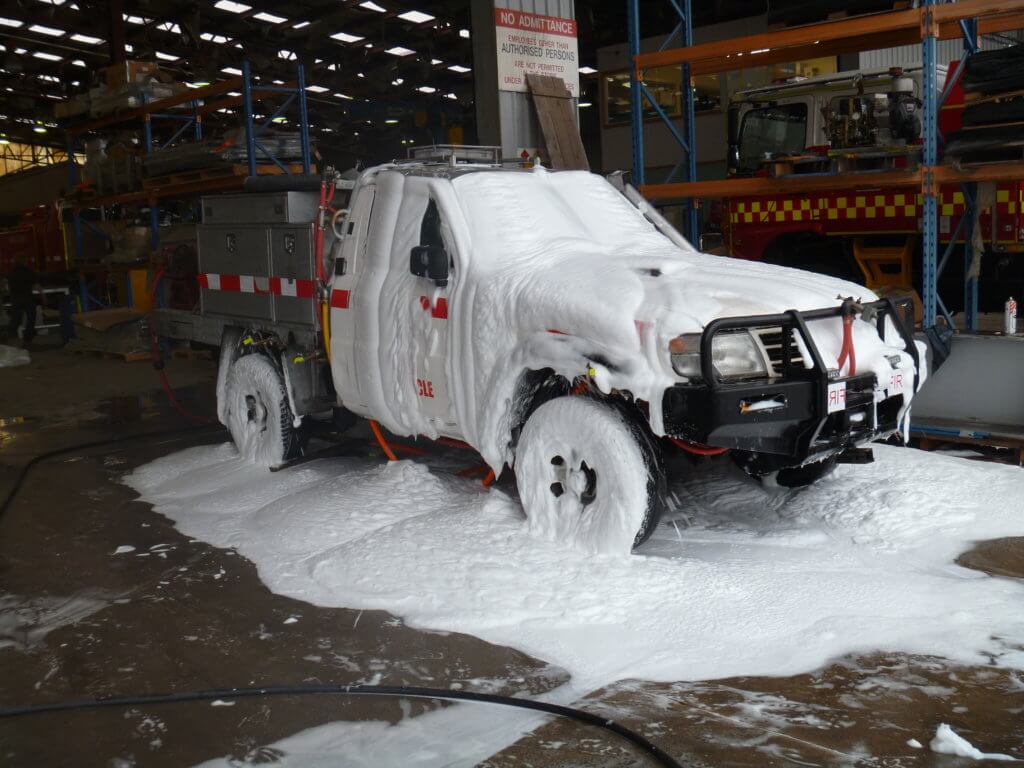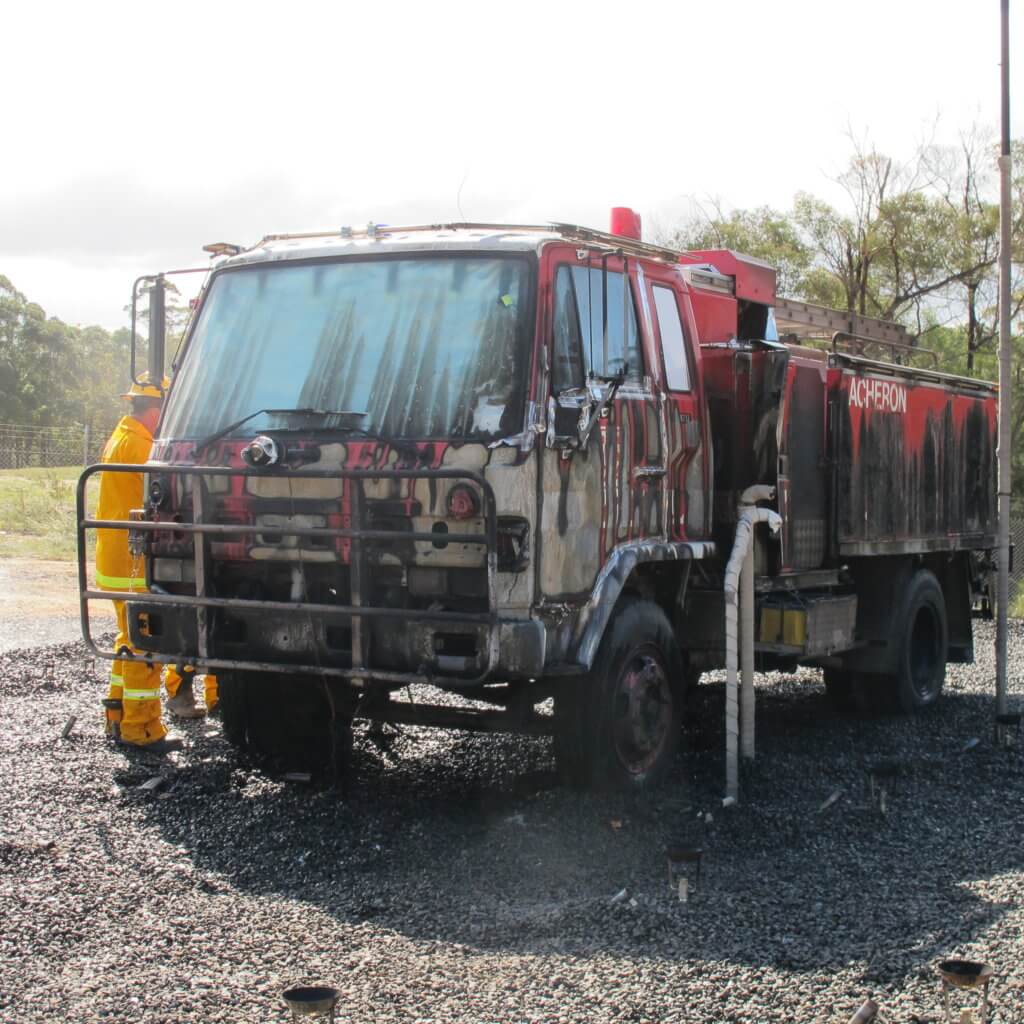Engineering A Safer Crew Protection System
By Andrew Webb and Andy Gooden 
Burn-over crew protection systems have been installed into fleets of rural wildland Fire-Fighting Vehicles (FFVs) in parts of Australia, successfully providing protection for crews in recent large fires. Research out of the Country Fire Authority (CFA) in Victoria is leading the change in vehicles carrying more than 1000 litres of water.
These systems, and underlying engineering design principles, are robust and have remained largely unchanged since first introduced as standard fitment in Victoria in the mid 2000’s. Where utilized there have been no recorded firefighter deaths, and only minor injury, from burn-overs. Most notably during the Victorian Black Saturday bushfires in February 2009 hundreds of FFVs were involved in firefighting operations with eight involved in significant burnover situations and a further 18 directly impacted by fire. In the recent 2019-20 bushfires in New South Wales and Victoria that burnt out of control for many months the same result occurred – multiple burn-overs without deaths or significant injuries.
Principal engineering features, described in detail online [https://www.iawfonline.org/wildfiremagazine], form part of the overall layered approach as described in Wildfire magazine, (March-April 2017, p 28-30 “Developing and Testing a Tanker/ Engine Crew Protection System”, D Nichols, CFA Manager of Research and Development).
These include:
1) Cabin and body skin/panelling heat shielding and critical lagging
2) Water deluge system
3) Radiant heat shielding curtains
4) Fire blankets and Personal Protective Equipment (PPE)
CFA Engineering was tasked to design and implement a resilient and reliable system around this layered approach. Prior research in this field was limited so the system had to be largely designed from scratch.
The system needed to be
- Sufficiently robust to withstand day-to-day off-road operations in heavily forested environments and open grassland plains.
- Able to remain operable for a minimum of five minutes (the accepted benchmark burn-over duration) when subject to radiant heat loading of at least 5000 kW/m2 and full flame immersion with temperatures approaching 1000 0C.
- Passively operable following initial simple discretionary activation protocols.
The system was developed from much of the research and development that was detailed in the 2017 Wildfire article and supported by practical experimentation. Developmental work commenced in the early 2000s in collaboration with the Australian research organisation CSIRO (Commonwealth Scientific and Industrial Research Organisation).
Testing has included:
- Controlled laboratory experiments to understand flammability and heat transfer characteristics of various relevant protective material layers and proposed insulating coatings.
- A series of experimental burns at the NSW Rural Fire Service owned gas-fuelled flame front simulator located at the Hot Fire Training Facility at Mogo New South Wales.
- Field validation tests in forested and open grass land environments. Most notably:
- February 2004 – Maragle State Forest, Tumbarumba, NSW – two forest field trials
- March 2014 – Wangaratta, Victoria – open grass fire field validation
- March 2017 – Brucknell Forest, Timboon, Victoria – forest field trial
The system has since been adapted to a range of vehicles in a major retrofit program undertaken by the CFA between 2010-14. More than 1000 vehicles were modified covering a wide variety of size, configuration and age.
Several key engineering design principles have been developed.
Cabin and body skin/panelling heat shielding and critical lagging
Fire agencies throughout Australia use commercially available cab chassis as platforms for customised fire fighting vehicle bodies. Cab chassis are typically sourced from Japan or Europe. They undergo a range of local modifications to make them suitable for use in arduous environments and to maintain critical operational functionality and cabin integrity during a burn-over.
These include:
- Plastic brake and fuel lines are lagged/sleeved, shielded or replaced with high temperature flame resistant equivalents to ensure the vehicle remains mobile and critical firefighting functions operable.
- Radiant heat shield panelling is placed around body critical elements such as batteries, pump and plumbing systems.
- Vulnerable cabin exterior plastic panels are replaced with metal, or non-flammable equivalents, to minimise the possibility of radiant heat/flame intrusion into the cabin interior.
Water deluge system – pumps and plumbing Traditional Australian tanker engines use a stand-alone onboard diesel engine driven fire-fighting pump with capacity in the range 100 – 1000 litres/min and a centrally mounted water tank varying in size from 500L – 4000 litres.
For CFA vehicles the last quarter is held as a discretionary reserve and is a trigger for fire-fighters to leave the fire ground. It is also sufficient for the minimum five minute water deluge system operation. Depending on the size of vehicle up to 750L of tank water is held in reserve.
After manual activation the system requires no further operator intervention. The pump and tank supply a self-replenishing water curtain to protected surfaces via up to 30 small strategically positioned spray nozzles – on cabin windows, external body panelling and tyres. Water run-off provides a wetted fuel load immediately around and under the vehicle to mitigate flame progression and burn-under. The system operates at total flow rates of 75 – 150 l/min – depending on the size of the vehicle.
Radiant heat shielding curtains
Cabin glassed areas are the major entry points for radiant heat and the greatest hazard to fire-fighters inside the cabin. Cabin windows are protected internally using Radiant Heat Shielding Curtains with a highly reflective outer layer and insulating inner layers.
CFA has successfully tested two curtains:
• Thermaguard Radiant Heat shields
• Storm King Mountain® Fire Curtains
These are typically multi-layered. Thermaguard’s Supertherm Radiant Heat Shield curtains comprise:
• a highly reflective outer aluminium foil
• a kevlar layer imparting tensile strength and flame resistance
• a proprietary, glass free, insulating core mitigating potential carcinogenic risks
• an internal fabric liner.
Careful design consideration has been made to ensure rigid mounting, compact stowage and rapid deployment. The curtains are stowed in a rolled-up fashion, immediately above each window for rapid “drop down” deployment via quick release tabs. Upper edges are mechanically fastened to a metal surface. Curtains are deployable in any order to reduce cognitive stress. Compactness of the stowed curtain roll, particularly over the front windscreen, is critical to maintain the driver’s forward field of vision.
Stand-alone ongoing fail-safe operation following initial activation
Fire fighting water pumps are driven by compression ignition diesel engines that are inherently safe. Burnover fail-safe operation has been enhanced by providing:
• An all metal air filter/pre-cleaner and fire retardant filter element to mitigate combustion air starvation
• A small fuel header tank fed from the main cab chassis engine fuel supply sufficient for stand-alone supply during a burn-over
• “Energise-to-stop” control functionality, meaning failure of electric control does not stop pump operation.
• Protection for the pump/engine assembly and critical plumbing behind radiant heat shield panelling.
Alternative deluge systems for small volume water tanker engines
The water deluge system described above is increasingly problematic for smaller fire-fighting vehicles, particularly those with less than 1000L on-board water storage. Too much water held in discretionary reserve is seen as operationally prohibitive for normal firefighting. Alternative water enhancing systems have been developed to increase water surface adhesion properties and minimise run-off effects. Two systems have been prototyped and successfully benchmark tested, both using around 50-60 L of water for the five minute burn-over window:
• Compressed Air Foam (CAF)
• Polymer GEL
The CAF system has been endorsed for further production development by CFA. The system inductively mixes 1% Class A foam (Phos-Check WD-881) with water (10 l/min) and compressed air (125 cfm at 180 kpa). The mixture is then distributed to strategically placed plenum expansion chambers resulting in a gravity fed, self-replenishing, CAF blanket that forms over critical surfaces.
Compressed air is sourced via a regulated 6.8L/300 bar firefighter Breathing Apparatus (BA) cylinder sufficient for 9 minutes of operation.
The Polymer GEL system uses 3% Barricade GEL premixed with water that is sprayed onto critical surfaces as a one-shot system. The delivery system includes a series of “pop-out” nozzles and common feeder plumbing. It can be deployed at any time prior to the approaching fire-front.
Both systems are part of a layered protection approach and use the radiant heat shielding curtains described above.
Further details on these design principles and additional references are available online www.iawfonline.org
About the Authors:
Andrew Webb is CFA’s Engineering Manager since 2012 responsible for the development and build of approximately 100 new urban, wildfire and specialist fire fighting vehicles each year. In 2010-11 Andrew was responsible for designing the crew protection system retrofitted to more than 1,000 of CFA’s wildfire tankers. [email protected]
Andy Gooden has 30 years experience in mechanical and chemical engineering, safety, international standards and testing, intellectual property law, and construction. He is a passionate proponent of crew protection innovation,
weighing the science as well as the practicalities, and enjoys supporting likeminded organisations [email protected]

